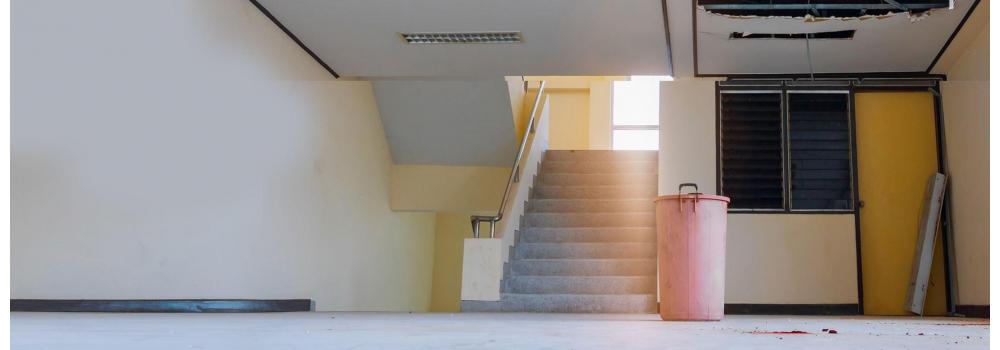From heavy rainstorms and plumbing leaks to hidden condensation and excess humidity, water can be a serious pain point for campus facility managers. Water damage doesn’t just come with costly repairs; it also can take away time spent in the classroom and cause harm to students and staff if it goes unnoticed.
Water-related issues can be challenging and costly to address once the damage is done. With a few proactive measures, education facilities managers can learn about signs of a water leak early on and ways to prevent damage to campus facilities.
When Your Building Structure Fails
At one elementary school in Portland, Oregon, heavy, rain-soaked ceiling tiles and carpet spurred fungus to grow in some rooms, according to local NBC affiliate KGW8. Students and teachers were relocated to another building for more than a month while contractors completed a $1.4 million project to replace the roof at the school. Had the Portland school not temporarily moved the students and staff, they could have been exposed to the negative side effects of unwanted or excessive moisture in the building.
According to the Centers for Disease Control and Prevention, exposure to building dampness and mold has been linked to respiratory symptoms, asthma, hypersensitivity pneumonitis, rhinosinusitis, bronchitis and respiratory infections.
In November 2019, a California school district turned to local investigative reporters to find out why their students and staff were so sick. It turns out toxic mold was lurking behind the walls, in the ceilings and the carpet – the culprit? High moisture levels. The investigation found in California, there are no laws requiring schools to conduct routine mold-testing, and it referenced California’s most recent state report on the topic from 2004, which found that the majority of California schools reported signs of moisture or mold in their classroom. The reporter linked the mold spores to allergies and asthma, noting the number one cause of chronic school absence as asthma, with as many as 3 million collective missed school days a year.
Condensation from High Humidity Levels
School buildings with high humidity levels have extra water in the air that can facilitate the growth of mold, fungus and dust mites, which can be harmful to the health of students and teachers. In addition, high humidity levels can damage building materials if condensation forms inside the ceilings, walls and windows.
To prevent water damage and the growth of mold and fungus, the Environmental Protection Agency (EPA) recommends using air conditioners and dehumidifiers to control humidity levels and dampness. In addition, adequate ventilation can help maintain indoor humidity levels between 30 and 60%. In addition, whenever cooking, dishwashing and cleaning in foodservice areas, it’s paramount to use an exhaust fan.
Know the Signs of Moisture, Leaks and Mold
The EPA recommends proactively inspecting buildings for signs of mold, moisture, leaks and spills. An inspection checklist may include:
- Checking for moldy odors
- Identifying water stains or discoloration on the ceiling, walls, floors and windowsills
- Looking in bathrooms, including around and under sinks, for standing water, water stains or mold
- Precluding water to stand in air conditioning units or refrigerator drip pans
Monitor with Smart Sensors
While some water leaks are obvious with water pouring down walls, leaks caused by high humidity levels can lead to moisture issues going unnoticed for an extended period of time. Facility managers can continuously monitor for the presence of water across their school campus with new devices like, OneVue Sense Temperature and Humidity Sensor, which issue audible and visual alarms when out-of-range conditions are detected and immediately alerts the appropriate person via email, text or phone call. Another sensor option is the OneVue Sense Water Leak Detector, which provides real-time alerts of any signs of unwanted moisture. The networked detectors can send alarms through text, email or phone, as well as sound a local alert for anyone in or near the room. Backed by OneVue Monitor software, the water leak detectors also provide comprehensive monitoring reports that can be quickly and easily generated from any desktop or mobile device.
With the OneVue system in place, education facility mangers can be made aware of moisture, which can be particularly critical for difficult-to-monitor places, before the issue compounds into a significant problem.
With the health and safety of all students, teachers and staff top of mind for facility managers, schools should implement preventative measures to detect and flag any potential water leaks or dampness.
For more information about how you can help strengthen your school’s moisture and water leak detection, visit www.primexinc.com/education.
